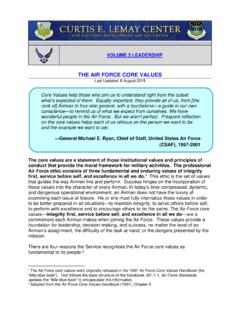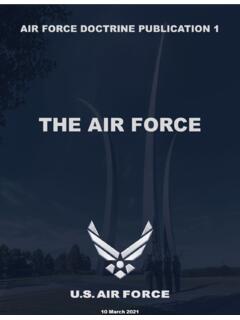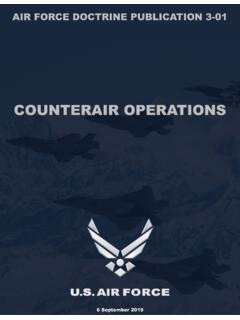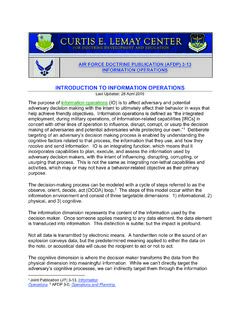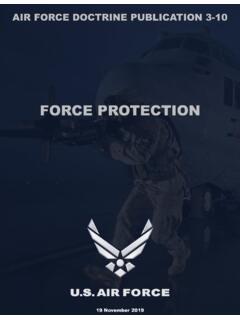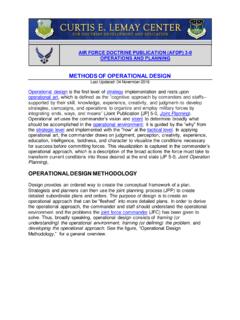Transcription of CATALOG OF DOCTRINE TOPICS
1 1 CATALOG OF DOCTRINE TOPICS CHAPTER ONE Introduction to Operations Operations and War Cross-Domain Integration Airpower as Maneuver in Warfare Parallel and Asymmetric Operations The Range of Military Operations Campaigns in Peacetime CHAPTER TWO Overview of Operational Processes The Effects-Based Approach to Operations (EBAO) Operational Design Practical Design Considerations Planning Executing Operations Assessment CHAPTER THREE Commanding and Organizing Air Force Forces The Commander, Air Force Forces Regional vs. Functional Organization The Air Expeditionary Task Force AETF Organization Command and Control Mechanisms Distributed/Split Operations Command Relationship Models for Air Force Forces Transfer of Functional Forces to a Geographic Command Integrating Regional and Functional Air Force Forces Integrating the Air Reserve Components Homeland Organizational Considerations The Senior/Host Air Force Installation Commander CHAPTER FOUR The Air Force Component Within the Joint Force The Joint Force Air Component Commander Air Force Component Presentation Considerations Joint Air Component Coordination Element Miscellaneous Joint Notes Multi-Hatting Commanders/Span of Command LEGEND Green underlined text denotes a link to glossary terms (definitions and acronyms).
2 Blue underlined text denotes a link to another source document within the DOCTRINE database. VOLUME 3 COMMAND 2 CHAPTER ONE: INTRODUCTION TO OPERATIONS Last Updated: 22 Nov 2016 (Note: The information in this section is condensed from material from Air Force DOCTRINE (AFD) Annex 3-0, Operations and Planning. Refer to that document for more detailed overall discussion and context. Other links may point to more specific discussion or to other supplementary sources. Also, any bolded emphasis is in the original text.) Purpose of this Product This product is a synopsis of key points across the DOCTRINE database. Its purpose is to provide senior leaders with a quick review of key doctrinal points across a wide range of material. It is not meant as a substitute for deeper familiarization with the referenced material.
3 Staff members supporting senior leadership should be familiar with the greater context found in the referenced sources. VOLUME 3 COMMAND 3 OPERATIONS AND WAR Last Updated: 22 Nov 2016 Not all military operations involve war, but war underpins the existence of all military Services, so DOCTRINE should include an understanding of war and its consequences. The most fundamental and important purpose of military forces is their employment as instruments of national power to deter or win wars. War is a violent struggle between rival parties to attain competing objectives also described as socially sanctioned violence to achieve a political purpose (Joint Publication (JP) 1, DOCTRINE for the Armed Forces of the United States). War has been deeply-rooted in human experience since the earliest times.
4 War remains an instrument of policy used by nation states, sub-national entities, or supra-national groups to achieve disputed aims. For the complete discussion of this topic, click here. Traditional and Irregular Warfare Typically, US military DOCTRINE frames warfare as traditional or irregular. Traditional warfare is characterized as a violent struggle for domination between nation-states or coalitions and alliances of nation-states (JP 1). Traditional warfare typically involves force-on-force military operations in which adversaries employ a variety of conventional military capabilities against each other in the air, land, maritime, space, and cyberspace domains. Objectives in traditional warfare may be to coerce key military or political decision makers, defeat an adversary s armed forces, destroy an adversary s war-making capacity, or seize or retain territory in order to force a change in an adversary s government or policies.
5 Irregular warfare (IW) is a violent struggle among state and non-state actors for legitimacy and influence over the relevant population(s). Irregular warfare favors indirect and asymmetric approaches, though it may employ the full range of VOLUME 3 COMMAND 4military and other capacities, in order to erode an adversary's power, influence, and will (JP 1). The focus of IW is not on large-scale combat or the destructive capability of an adversary s military forces. Typically, a less powerful adversary seeks to disrupt or negate the military advantage of a more powerful foe, often an established regime, through small engagements intended to demoralize the foe s military, or attacks on nonmilitary targets in order to influence or control a local populace. IW is not a lesser-included form of traditional warfare.
6 IW encompasses a variety of operations where the nature and characteristics are significantly different from traditional war. IW consists of five principle activities or operations undertaken in sequence, in parallel, or in blended form in coherent campaigns to address irregular threats: counterterrorism, unconventional warfare, foreign internal defense, counterinsurgency, and stability operations. Traditional warfare and irregular warfare are not mutually exclusive; both forms of warfare may be present in a given conflict. Airmen should understand that the character of war may often change in the course of a conflict. This is especially true in irregular warfare where the conflict is often protracted and varies in intensity. Traditional warfare can rapidly evolve into an irregular war and vice versa, requiring the military force to adapt from one form to the other.
7 Military forces should be prepared to conduct operations across the range of military operations (ROMO), but they are ultimately tested by their ability to prevail in war. The advent of air forces revolutionized many aspects of armed conflict, but did not fundamentally change the nature of war or the enduring insights guiding strategy. The opening of space and cyberspace domains to military action has not fundamentally changed these insights either, even though it increased complexity of-and opportunities available through-military operations. For the complete discussion of this topic, click here. 5 CROSS-DOMAIN INTEGRATION Last Updated: 22 Nov 2016 Military operations take place in and through the air, land, maritime, space, and cyberspace domains and the information environment.
8 The information environment is comprised of the physical, informational, and cognitive dimensions. Information operations primarily focuses on affecting the cognitive dimension, where human decision making occurs, through the physical and information dimensions. Control of one domain, particularly land, can secure success of a military operation, but control of, or influence through more than one domain usually helps achieve continuing advantage more effectively and efficiently. The Air Force exploits advantages in the air, space, and cyberspace domains to achieve joint force commander (JFC) and national objectives in all domains and the information environment. These functions can be conducted independently from land and maritime operations or can complement, support, or be supported by, land and maritime operations.
9 Air superiority is normally a desired state before all other combat operations. Air superiority and air supremacy, when required helps provide both the freedom to attack and freedom from attack, as well as enhancing freedom to maneuver. Operating without air superiority or supremacy radically increases risk to surface and air operations. Space superiority is important in maintaining unique advantages in precision applications, global command and control (C2), situational awareness and understanding, and operational reach. Cyberspace operations are also vital for maintaining advantages in all domains. For the complete discussion of this topic, click here. VOLUME 3 COMMAND 6 AIRPOWER AS MANEUVER IN WARFARE Last Updated: 22 Nov 2016 Airpower is the ability to project military power or influence through the control and exploitation of air, space, and cyberspace to achieve strategic, operational, or tactical objectives.
10 Airpower exploits the third dimension of the operational environment; the electromagnetic spectrum; and time to leverage speed, range, flexibility, precision, tempo, and lethality to create effects from and within the air, space, and cyberspace domains. Airpower leverages military, civil, and commercial capabilities, the industrial infrastructure, and a DOCTRINE of employment. Airpower is an indivisible, unitary construct one that unifies Airmen, rather than portraying them as a collection of tribes broken into technological or organizational stovepipes. Due to speed, range, and its multidimensional perspective, airpower operates in ways that are fundamentally different from other forms of military power; thus, the various aspects of airpower are more akin to each other than to the other forms of military power.


